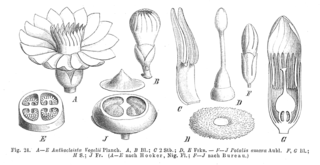
Gentiana acaulis, the stemless gentian, or trumpet gentian, is a species of flowering plant in the family Gentianaceae, native to central and southern Europe, from Spain east to the Balkans, growing especially in mountainous regions, such as the Alps and Pyrenees, at heights of 800–3,000 m (2,625–9,843 ft).

The Mathematical Association of America (MAA) is a professional society that focuses on mathematics accessible at the undergraduate level. Members include university, college, and high school teachers; graduate and undergraduate students; pure and applied mathematicians; computer scientists; statisticians; and many others in academia, government, business, and industry.

The Passifloraceae are a family of flowering plants, containing about 750 species classified in around 27 genera.

Gentianaceae is a family of flowering plants of 103 genera and about 1600 species.

The Loganiaceae are a family of flowering plants classified in order Gentianales. The family includes up to 13 genera, distributed around the world's tropics. There are not any great morphological characteristics to distinguish these taxa from others in the order Gentianales.

Gelsemiaceae is a family of flowering plants, belonging to the order Gentianales. The family contains only three genera: Gelsemium, Mostuea and Pteleocarpa. Gelsemium has three species, one native to Southeast Asia and southern China and two native to Central America, Mexico, and the southeastern United States. The eight species of Mostuea are native to tropical areas of South America, Africa, and Madagascar. The two genera were formerly classified in the family Loganiaceae. Pteleocarpa was originally placed in Boraginaceae or in its own family Pteleocarpaceae, but it is most closely related to Gelsemiaceae with which it shares significant characters.

The genus Macrocarpaea, with 105 species and two hybrids of 0.5 m herbs, shrubs, epiphytes and small trees to 10 m tall, is the largest genus of the tribe Helieae of the gentian family (Gentianaceae). Species of Macrocarpaea have diurnal and nocturnal pollinators, visited during the day by hummingbirds, insects and butterflies, and at night by bats, moths and many different kinds of insects. The common name for the genus is 'Moon-gentian'. No species are known in cultivation.
Paulus Johannes Maria "Paul" Maas is a botanist from the Netherlands and a specialist in the flora of the neotropics. Maas has identified and named about two hundred fifty plants from the Burmanniaceae, the Costus Family (Costaceae), the Gentian Family (Gentianaceae), the Bloodwort Family (Haemodoraceae), the Banana Family (Musaceae), the Olacaceae, the Triuridaceae, and the Ginger Family (Zingiberaceae).
Alfred Struwe was a German actor, best known for his television role as Dr. Alexander Wittkugel in Zahn um Zahn.

Voyria, commonly known as ghostplants, is a genus of 20 species of herbaceous perennial plants, belonging to the family Gentianaceae. They are mostly native to warm temperate and tropical regions of the Caribbean, Central America and South America, except for V. primuloides, which is found in West and Central Africa. V. parasitica reaches as far north as the Everglades in Florida.

Cerro de la Neblina, also known as Serra da Neblina in Brazil and Sierra de la Neblina in Venezuela, is a sandstone massif located in the northern Amazon Basin. It is a tilted, heavily eroded plateau, with a deep canyon in its central portion, drained by the Baria River.
Rydingia (tinjute) is a genus of plants in the family Lamiaceae, first described in 2007. The genus is native to eastern Africa and south-western Asia, and found in Eritrea, Ethiopia, Iran, Oman, Pakistan, West Himalaya and Yemen.

Symbolanthus, the ring‐gentians, are a genus of flowering plants in the family Gentianaceae, native to the montane tropics of southern Central America and northern and eastern South America.
Yanomamua is a genus of flowering plants belonging to the family Gentianaceae.
Chorisepalum is a genus of flowering plants belonging to the family Gentianaceae.
Roraimaea is a genus of flowering plants belonging to the family Gentianaceae.

Potalia is a genus of flowering plants belonging to the family Gentianaceae.
Sipapoantha is a genus of flowering plants belonging to the family Gentianaceae.

Pentalepis is a genus of flowering plants in the family Asteraceae which is endemic to Australia and found only in the Northern Territory and Western Australia.











